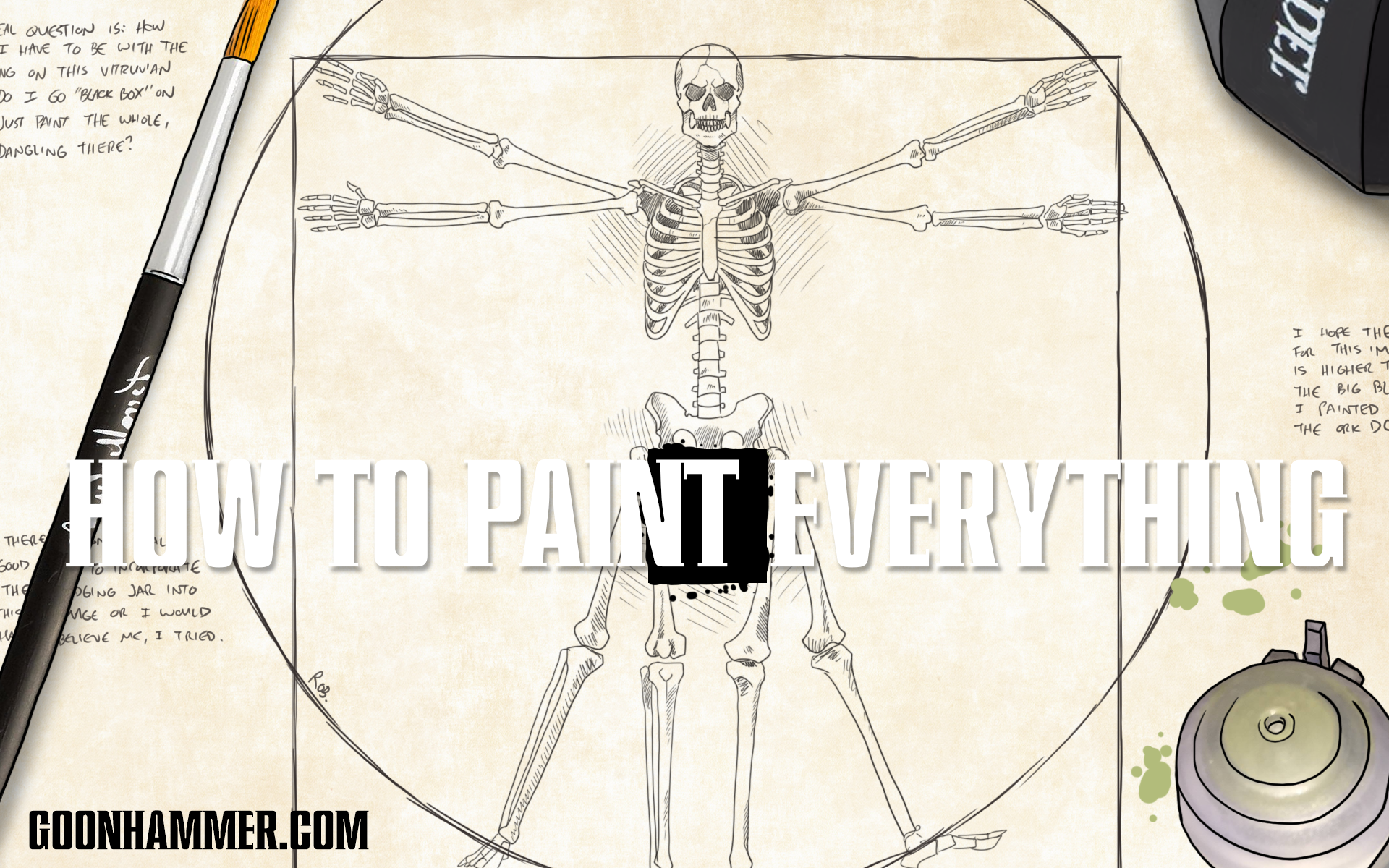In our How to Paint Everything series, we take a look at different armies of the Warhammer universe, examine their history and heraldry, and look at several different methods for painting them. With Halloween fast approaching, we’re looking at how to paint the spookiest monsters around. In today’s HTPE, we’re looking at how to paint the other legions of the walking dead that eat human flesh. Not zombies, but Ghouls.
Far older conceptually than zombies, ghouls are demon-like beings or monsters that tend to hang out in graveyards and feast on human flesh. Ghouls originally come from pre-Islamic Arabian folklore, where they were said to dwell in cemeteries and were introduced in the western world when Antoine Galland translated One Thousand and One Nights into French. They got a second lease on fictional un-life in the early twentieth century when they were featured in HP Lovecraft’s short story, Pickman’s Model, in which a New Englander named Richard Pickman paints images of fearsome daemonic beasts with red eyes that devour and gnaw on the bones of the living. Since then, ghouls have lived on the periphery of our undead pantheon, thought of as more fearsome than say, Skeletons, but less culturally relevant than vampires or zombies, though the resemblance to both probably dooms them – they aren’t quite as grounded or “realistic” as zombies and they resemble pretty well the more feral incarnations of vampires, meaning that there often just doesn’t seem to be room for ghouls as main antagonists in modern movies. And so ghouls seldom get to be a story focus and are more often relegated to games that need “zombies, but stronger” for players to fight, such as in Dungeons and Dragons, where ghouls are basically stronger, meaner zombies.
In Age of Sigmar, the most notable use of ghouls is in the Flesh-Eater Courts, the former noble houses that followed Nagash in the Old World. The lords of these houses fell out of favor with Nagash at one point or another and were cursed by Nagash, twisting their bodies into loathsome shapes and giving them an insatiable hunger for flesh, dead or alive. Their curse has also driven them mad and despite being monstrous creatures fallen to cannibalism, they see themselves and each other as the nobles they once were, inhabiting great courts and luxurious halls. Where saner mortals see flayed flesh banners and blood-slicked ghouls marching to war, they see cloth regalia and noble knights, echoes of the kingdoms they once ruled. It’s pretty cool.
Where to Read/Watch More
Ok, so the list of ghoul-related works is going to feature a few things that are technically listed as vampires or zombies but really are ghouls. It’s a harder list to assemble, so bear with me on this.
- First off, if you want to go back to some of the original works, check out One Thousand and One Nights or HP Lovecraft’s Pickman’s Model. Standard caveats about Lovecraft being a racist shithead aside, the latter story is pretty good classic horror.
- In Vampire: The Masquerade, ghouls are humans who have been fed vampire blood. This turns them into the undead monsters we’re familiar with, and gives them some supernatural powers. In a similar fashion, the first Blade movie features a similar type of process, where ghouls are basically “failed vampires” where the process doesn’t take.
- Check out the Flesh-Eater Courts in Age of Sigmar for a cool, unique take on ghouls.
- Brian Keene’s 2007 horror novel Ghoul tells the tale of teenagers in the summer of 1984 being hunted by something sinister stalking a nearby graveyard.
Painting Ghouls
Painting ghouls is all about nailing two things, really: Pallid, sickly flesh and gross gore effects. Ghouls differ from zombies primarily in that they’re much more monstrous and tend to be less-clothed and are typically less humanoid. This means you can usually feel more free to play around with some more fantastic color combinations and aim for something a little more monstrous.
Lupe’s Method – Pale Horrors
I knew going in I had a very very specific aesthetic in mind for my ghouls. I wanted to make them almost ethereal, dirty pale creatures that looked like they had not seen sun for years. The flesh would be the focus for me, but I also wanted to offset it with some sense of the kind of materials and equipment these filthy creatures would have access to, so corrosion and dirt would be the name of the game. I also wanted to play around with some technical effects, and so these have a really grizzly, bloodstained look to them.
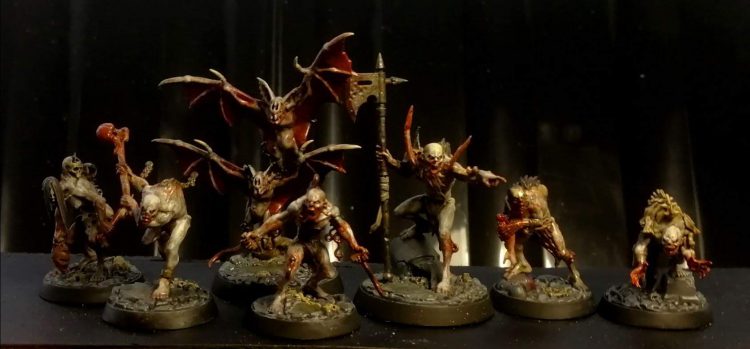
My basic fleshtone recipe was as follows:
- Make a ghoul flesh mix of 2:2:1 Rakarth Flesh : Ironrach Skin : White Scar and basecoat the skin
- Make a wash of 1:1:1 Reikland Fleshhade : Carroburg Crimson : Water and apply it over the skin
- Begin to highlight up, using your base mix at first, then slowly adding more white to the mix until your topmost highlight is almost pure white
- Make a wash of 1:2 Agrax Earthshade : Water and apply it over the skin
- Make a wash of 1:1 Druchii Purple : Water and apply it in the soft folds and crevices
- Make a was of 1:1 Carroburg Crimson : Water and apply it around the mouth, eyes, ears and other soft delicate tissues

Once the basic tones are in place, and after the rest of the model was finished (see below for the steps for that) it was time to add dirt, gore and grime. I used a 1:1 mix of Nuln Oil and water and added streaking and dirtt, especially around where cloth sits and also the feet, hands and forearms. Then using Vallejo Effects Fresh Blood and Old Blood I worked on the gore applying them thinly. The old blood I streaked wider around wounds, the mouth and the hands, making sure to wipe it into folds and crevices, and then used the fresh blood as highlight and to pick out the newest stains and scrapes. Finally using Vallejo Effects Vomit I applied some slickness and sickliness, particularly across the head, around any hair or fur, and across the shoulders and down the back of the arms.
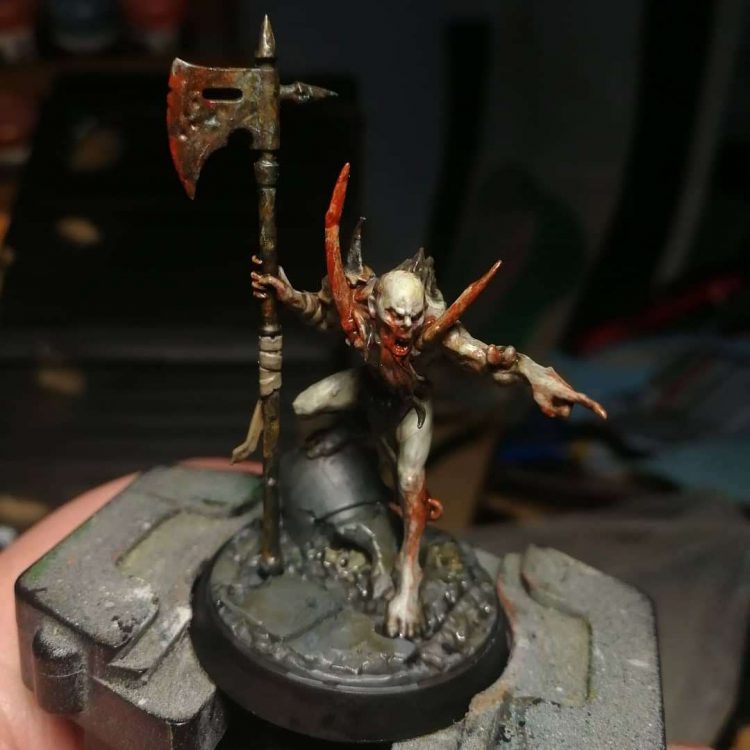
Bones I painted in Morghast Bone, then washed with a 1:1 mix of Nuln Oil and Seraphim Sepia. That dry, I lightly highlighted up with Ushbati Bone. I didn’t waste too much time on this as I knew this would be a place where blood and gore would cling heavily, so it wasn’t worth spending too much time on. I did something similar on the teeth, but picked them out finally in bright white on the very edges, even repainting this top highlight after the gore was applied, so that the glint of the teeth shone through.
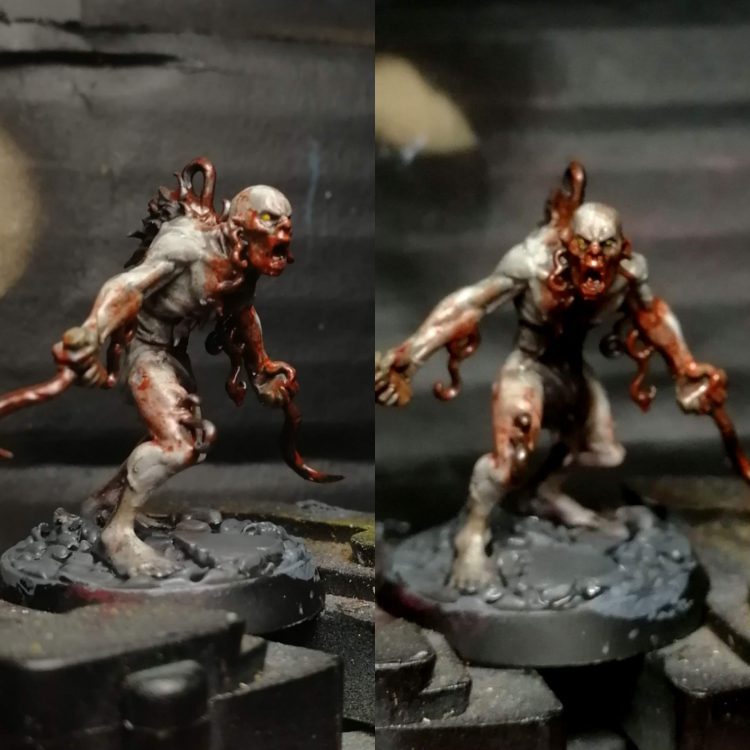
Metals I wanted to make dull and dirt, so I started with Scale 75 Black Metal, then washed with Nuln Oil. And that’s basically where I left it. For the larger areas with lots of rust, I used Skrag Brown and some Ryza Rust to bring those colours up, but I mostly wanted the dull glinting metal as a contrast to the skin.
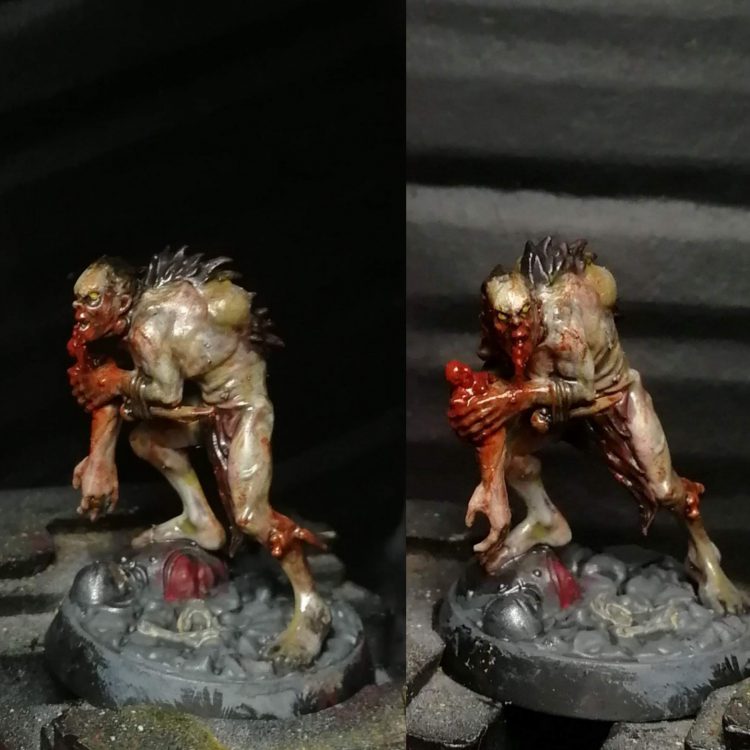
One of the models is eating an arm, and I wanted to really push the distinction between the skin tone on that and the tone on the ghoul. To this end I painted a really warm ruddy tone on the army, using Cadian Fleshtone, Reikland and then highlighting up with mixed in Ushbati Bone.
For the fur, I used a dark grey (Vallejo Black Grey) and then washed with Agrax Earthshade and highlighted up. I applied a coat of the Vallejo Effects Vomit to make it slick and shiny, but I don’t know how effective this was, and I might do this area differently if I were to paint more in the same scheme in the future.
This model in particular is supposed to be very rotten and deformed, so I went heavy with the vomit all over, giving her a glistening slick look.
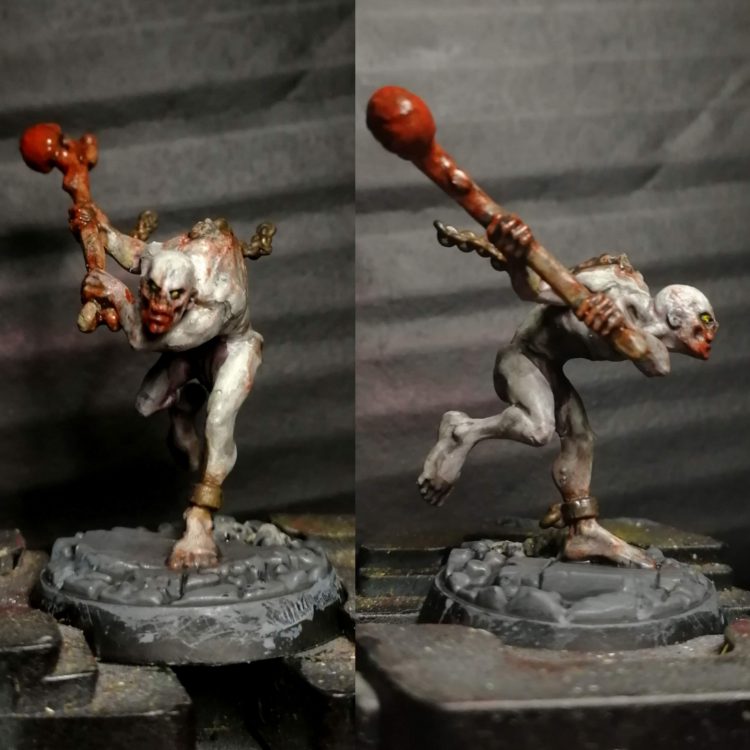
For the eyes I used Averland Sunset and then a little dot of Flash Gtiz. I made sure to heavily shade the eye socket with black to make them really stand out. bases I painted a neutral grey, washed and highlighted up simply before giving a little weathering too. I kept them simple and unobtrusive, as I didn’t want to distract from the pale ghouls.
Fowler’s Method
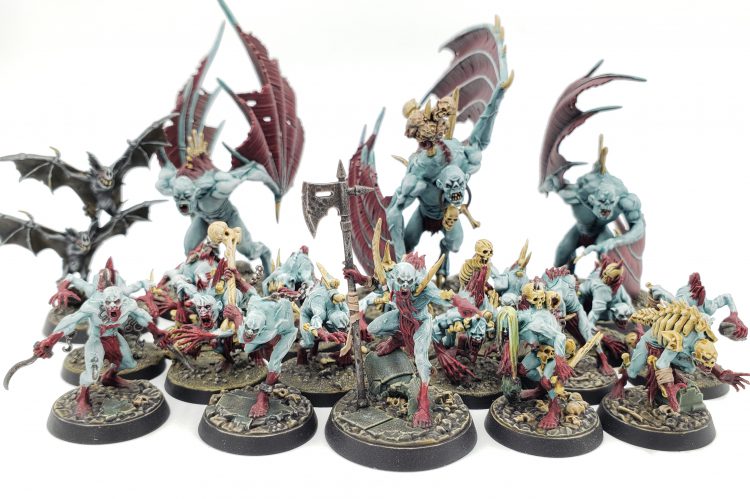
My ghouls are mainly for Warcry, but I wanted to keep their appearance somewhat consistent with my Nighthaunts. They are fellow denizens of the swamp / graveyard / ruined stormvault, and have suitably grimy basing. The scheme is similar in color to my Nighthaunts, but with the blue/green and red saturation flipped a bit. The blue and pale white gives off an unnerving “drowned” sort of vibe, which is perfect for swamp ghouls! These were a joy to paint, and I’m excited to take a crack at the Terrorgheist in the future!
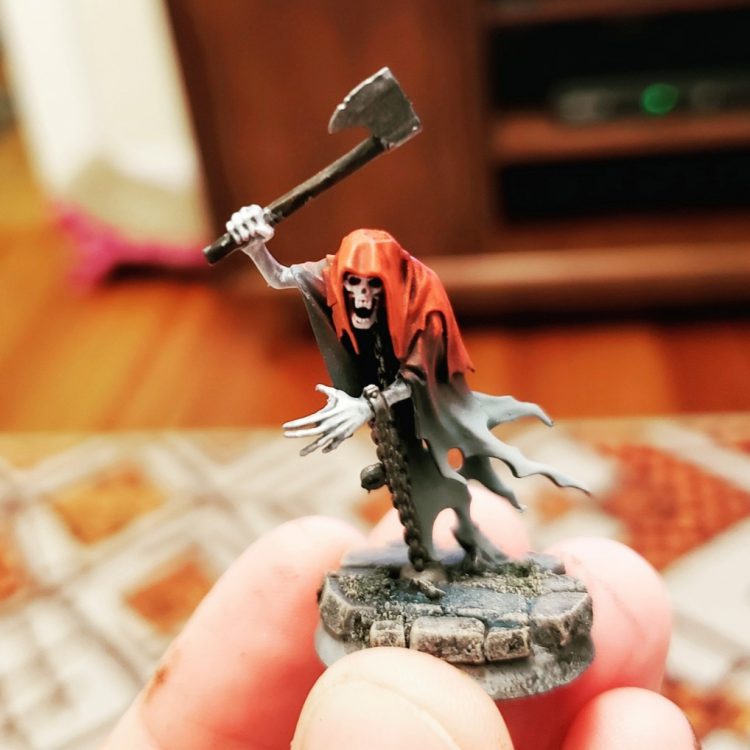
For speedy schemes that rely on washes and contrasts, a zenithal prime is your friend. I started by priming with black and aggressively spraying grey then white from the top to leave some shadows underneath the model. Don’t worry about getting too fancy with this – if you are really in a hurry you can just prime white and go. Next, wash a generous layer of Coelia Greenshare all over any areas of skin. Once that’s dry, use a big, soft drybrush (or ideally a cheap makeup brush) and build up some highlights with Ulthuan Grey.
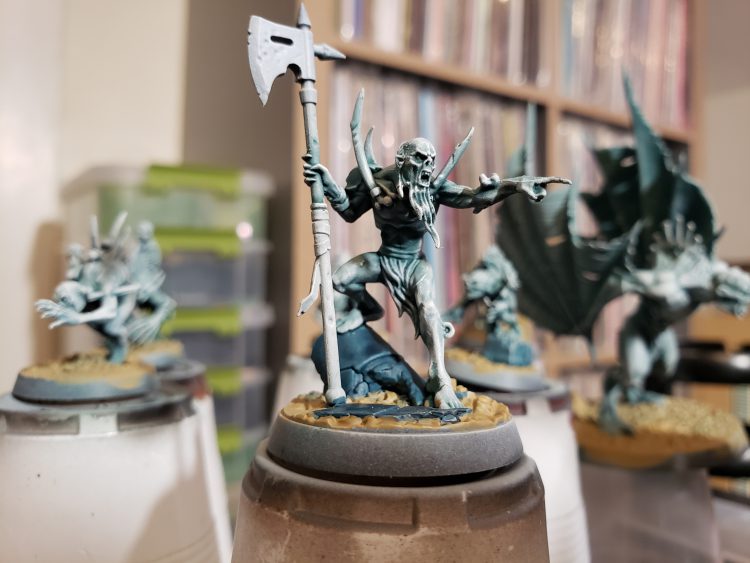
And that’s it for the skin. Seriously. The drybrushed highlights also help a bunch with the next step. Put Flesh Tearers Red contrast on fur, hair, and anywhere you want gore. I usually coat the hands, feet, mouth, and the occasional elbow or knee. Bone details get Ushabti Bone, Skeleton Horde Contrast, and highlights of Ushabti Bone and Screaming Skull.
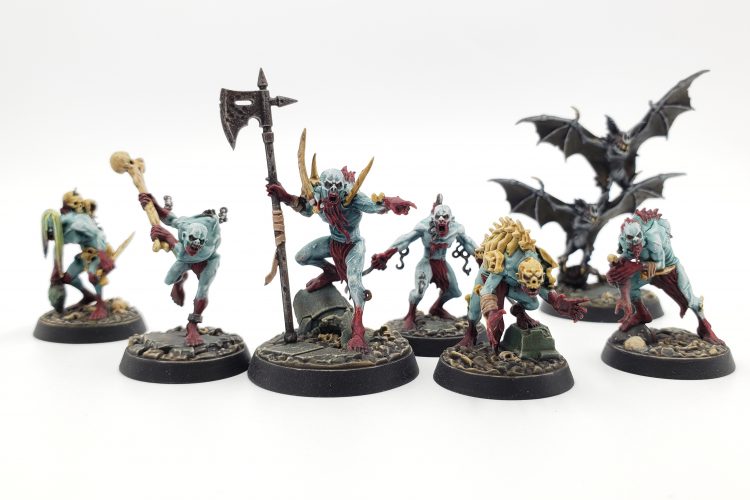
Eyes are just a touch of Khorne Red. Metallics get Vallejo Metal Color Gunmetal, Basilicanum Grey Contrast, a tiny bit of sponged bright orange (Troll Slayer Orange is a good pick here), and drybrushes of Runefang Steel and Necron Compound. Bandages are basecoated with Rakarth Flesh, washed with Agrax Earthshade and drybrushed with Ushabti Bone. Totally Optional – I ran some Tamiya Panel Liner Black in the recesses of wings and in the eye sockets – using contrasts carefully usually means you can benefit from a little extra recess shading and this is one of the most quick and efficient ways to do it!
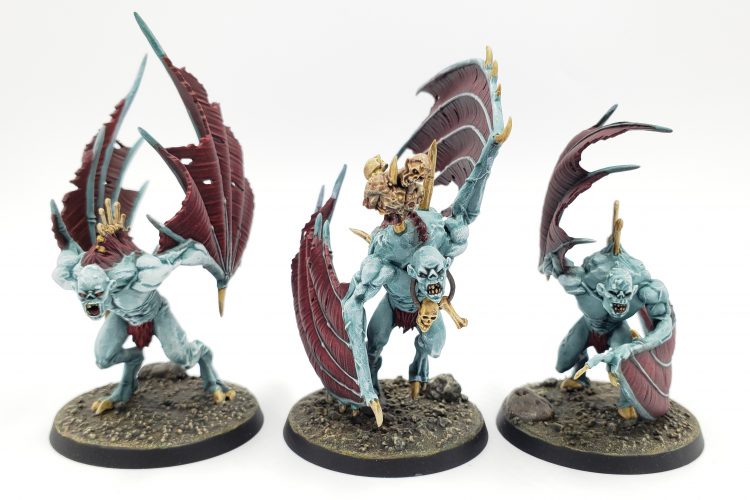
Kenji’s Method: Noble Knights of the Icy Realms
Flesh Eater Courts are my favorite AoS faction, as I love the idea behind their lore, but their models leave a little to be desired in terms of variety and interest. My goal in painting my army was to give them an interesting scheme that would also be quick, allowing me to put lavish detail and time into characters like the Arch-Regent, while making Ghouls and even Crypt Horrors a fairly simple process. Aside from the issue of variety, I also suffer a bit from limited hobby time and hobby fatigue, so when I have to paint the same thing over and over, I knew I had to make something workable. Also, to compensate for the models themselves, I placed a lot of thought into their bases, again wanting something easy but eye-catching, spending more time on characters and maintaining coherency throughout the army.
I do not own an airbrush, so all of these models are painted with spray on primers and then with a brush. Also, all of the paints I use here are GW paints (as those are the only ones sold in my area), and contrast paints play a pretty big role in this scheme. Finally, basing is something I wanted to spend time on with these models, as I feel it is a great way to add some extra color and character to each of these, while also keeping things uniform.
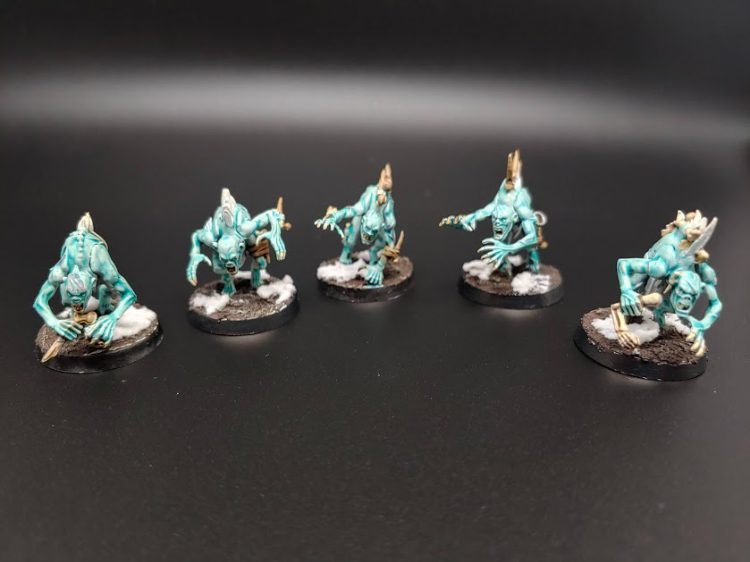
While snow basing and ice themed armies are good and excellent, I wanted something in mine that I felt could also mix well with the FEC theme of mad, ravenous beasts who think they are knights of Arthurian legend, so I decided to go for a ‘melting snow’ theme, with lots of dirt and some muddied snow, mixed with occasional flowers or plants to give surprising, weird bits of color. I figured this helped with the idea of a mixed up sense of self, as the bases can either be a time in which things are starting to freeze over but haven’t, or are starting to thaw but haven’t. Either way, it’s also an excuse for me to go wild with texture paints and stuff, so feel free to not do that if you just want to copy the paint!
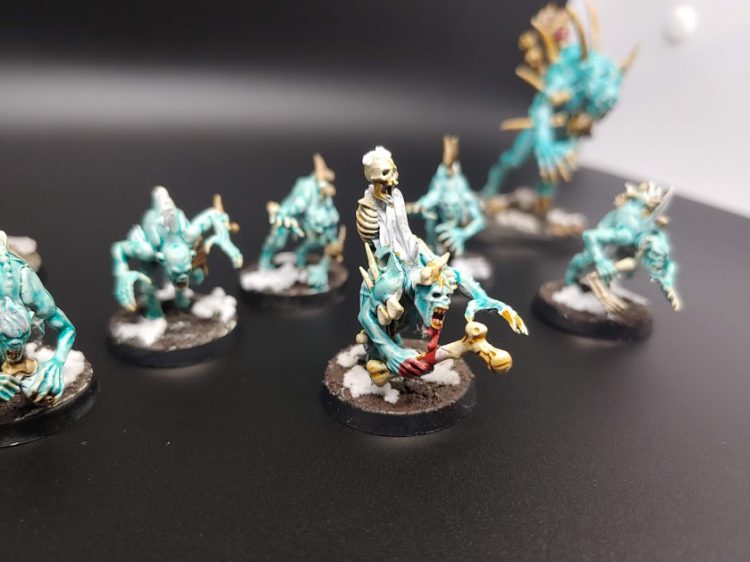
First, I primed with Wraithbone, although Grey Seer or even Corax White would probably work, but would likely change the next step quite a bit. What was important here is to make sure the color was smooth and all over, as all of the skin would be painted later using only contrast paints. For my Arch-Regent here, I wanted to make sure that an uneven spray can zenithal wouldn’t leave me with areas in which the contrast wouldn’t reach, and for the rest of the army I found a single coat was just faster than trying to do a Zenithal, especially since contrasts were such a big part of the picture.
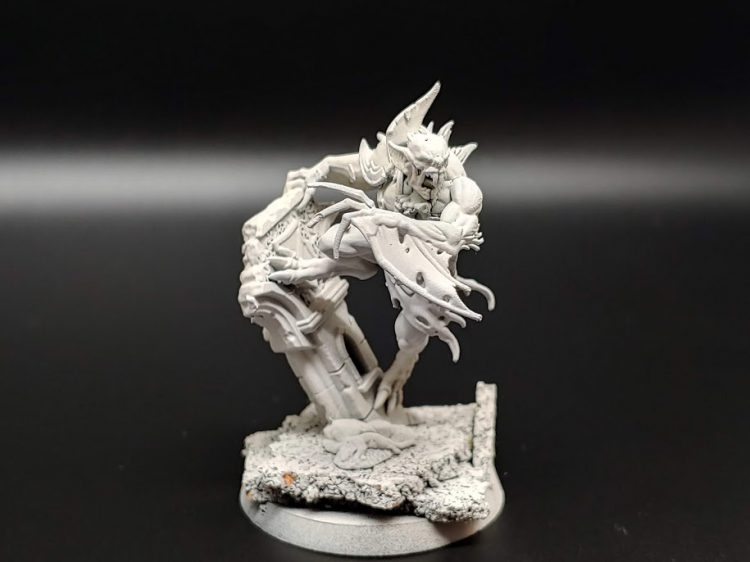
The next and most important step is the skin, which is a thinned Aethermatic Blue contrast paint. I start with a 5:3 ratio (5 parts Contrast Medium, 3 Aethermatic Blue) and do a few coats rather than one single coat. I find that thinning and doing smaller, lighter layers enables me to better control the contrast paint, and avoids making the models a bit too “blue” in the process. While I wouldn’t say things can go “wrong” here (as long as you like them!), these two models show a bit of the learning curve I had on thinning the paints. The first Crypt Horror below was without thinning the contrast, while the Crypt Flayer used a multi-coat approach. Both look good, but one looks a lot more “blue” while the other evokes an “icy”, “cool” feeling, which is what I wanted.
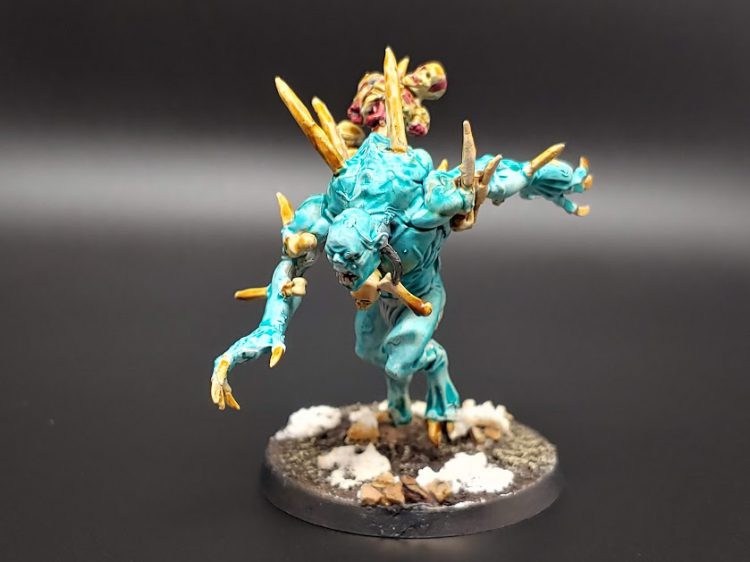
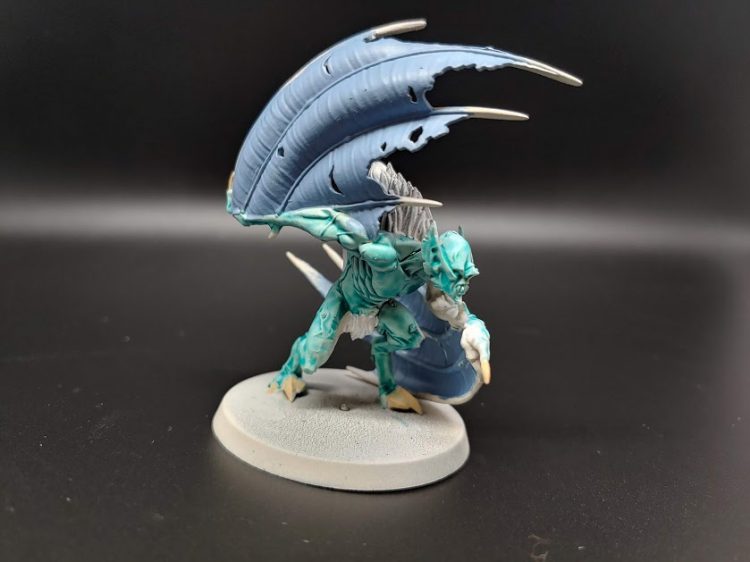
From there, the focus shifted to the other areas I could reasonably add color to most FEC models. I wanted my models to technically have 3 colors on them, so I picked a scheme of bone, white, and light pink to compliment the ice blue tone. For Ghouls, this meant making sure the bones and claws were given a coat of Skeleton Horde contrast, and the white tufts of fur were treated with a layer of Apothecary White contrast.
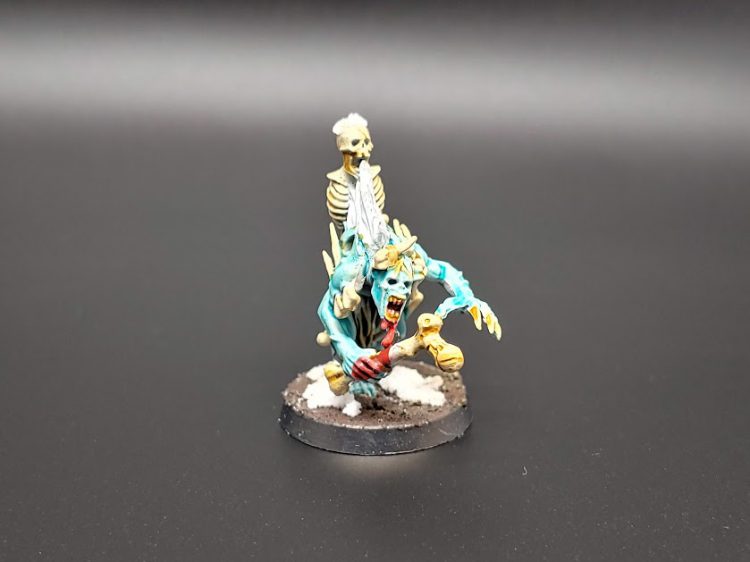
For Crypt Horrors and Flayers, I added in colors where applicable. On the Horrors, I added in some light pink by way of thinned Volupus Pink contrast in a 1:1 ratio of contrast to medium. This gave me a pink skin on areas that would look irritated, such as their spinal ridges, and on Flayers I used the same recipe and two coast to cover their wings, being sure to watch out for areas where it might pool or look mottled and weird. This also helped build some consistency with my Arch-Regent, who has pieces of all of the army theme on them (bone, fur, wings, claws, etc.) as well as extra details.

If you’re also working on an Arch-Regent (and I mean, why wouldn’t you, they’re one of the best models in the range both in detail and on the table!), then there are a few things the model has that other FEC don’t, namely: clothing. I didn’t want to move too far away from the rest of the army, and the crumbling pillar is a huge part of the base too (as well as the dead rat, don’t forget it!), so I got some base colors out and added on to the model. The tattered clothing is Doombull Brown, which I then washed with Reikland Fleshade and then highlighted with a coat of Doombull Brown mixed with some White Scar, and then an even lighter version of this mix for raised edges and corners. The shoulder and all other metal is Canoptek Alloy which I then coated in Cryptek Armourshade Gloss. The scenic base piece is coated in Zamesi Desert, washed a 1:1 mix of Agrax Earthshade and Nuln Oil, and then drybrushed with Zandri Dust and some Ushabti Bone. The claws, teeth, and skulls are a classic bone recipe of Ushabti Bone, Agrax Earthshade, Ushabti Bone again for a highlight, and then Screaming Skull and Pallid Wych Flesh as a final touch.
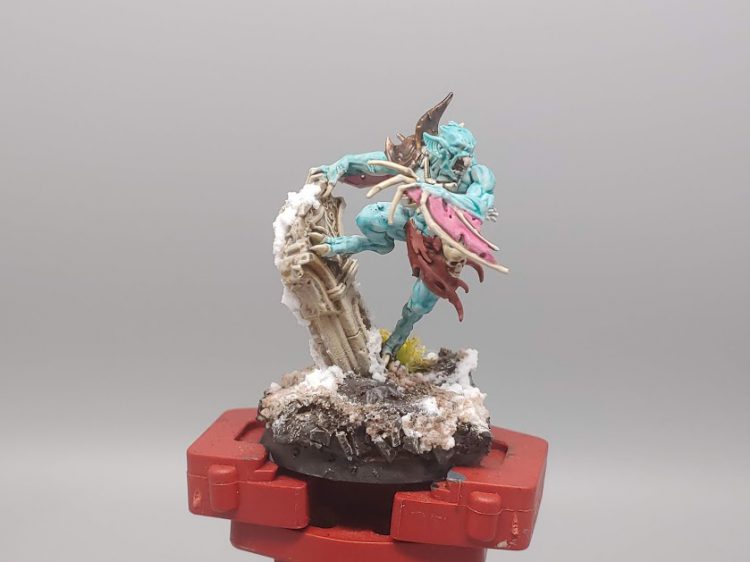
For the base, I started by layering cork, then secured the model to it. From there, I slathered on some Vallejo Earth Texture, and sprinkled in some random rocks while it dried. After that, I covered the dried mix in Stirland Mire texture paint, then washed the entire base in a mixture of Agrax Earthshade and Nuln Oil. On top of that worked in some Valhallan Blizzard, and dotted certain parts with some Agrax Earthshade to give it the look of snow mixed with dirt, as if it were not cold enough to maintain snow form. Finally, I added two flower tufts to give some color and life to the base.
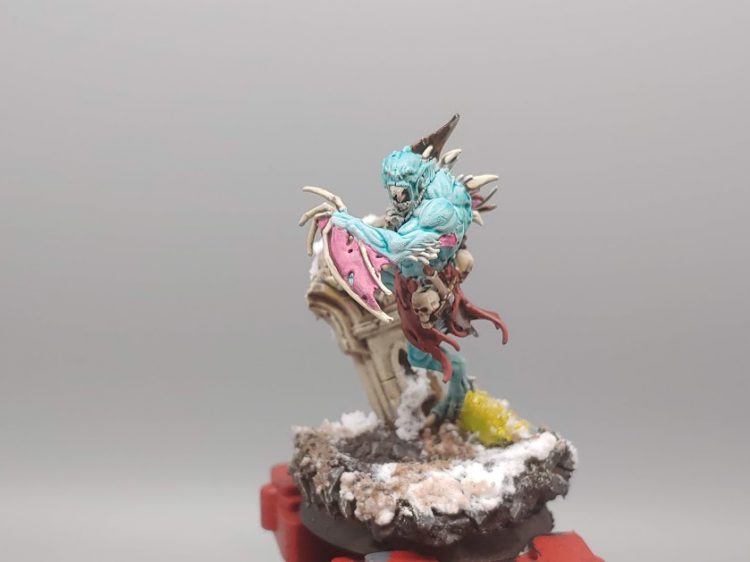
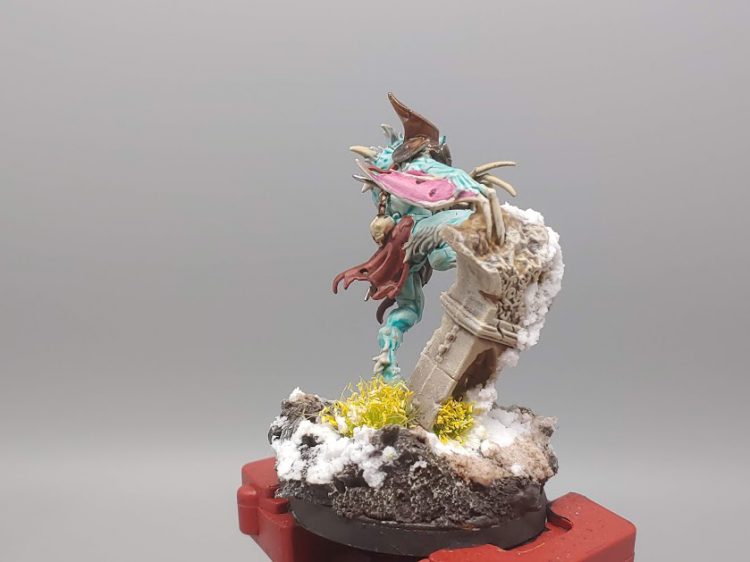
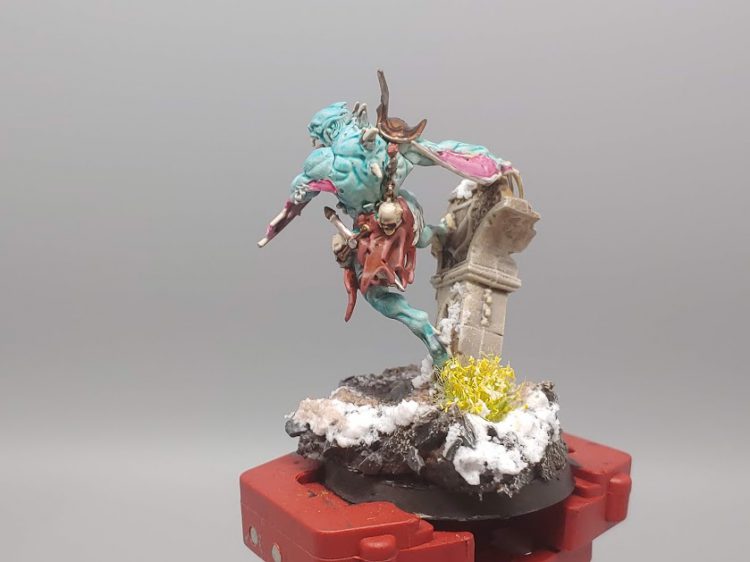
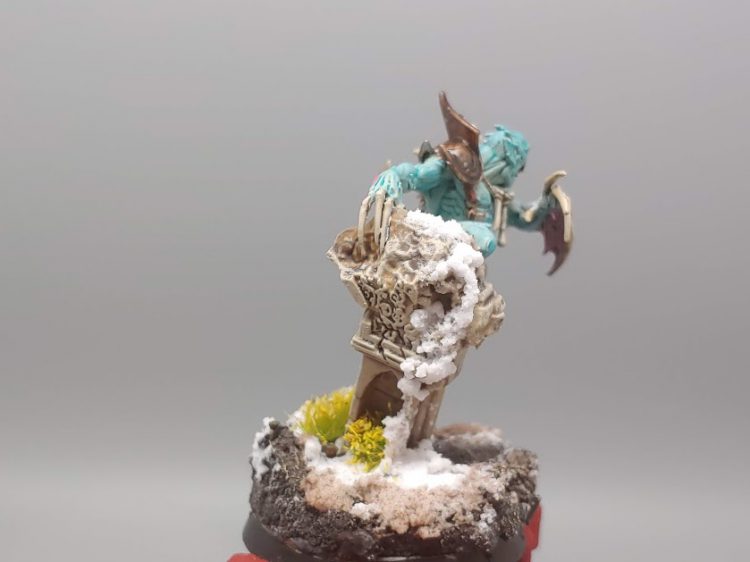
And that’s the army! I think reversing the paints (using Volupus Pink for the skin and Aethermatic Blue for the wings) would give an equally interesting effect, perhaps for a brave band of knights from a more fiery or temperate clime. No matter what, the overall scheme is fairly simple, and should allow you to blow through an army of FEC in no time.
It’s a Graveyard Smash
Have any questions or feedback? Drop us a note in the comments below or email us at contact@goonhammer.com.
